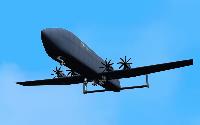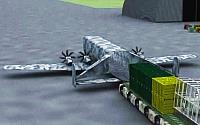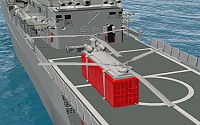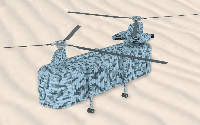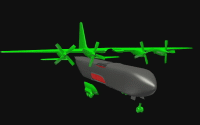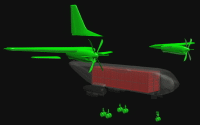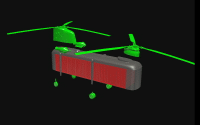|
Drone Cargo Aircraft Main Cost Reduction Factors:
- Drone cargo aircraft permit lower crash load requirements resulting in significant system weight reduction.
- Unmanned systems allow slower and lower flight operations targeting fuel efficiencies.
- Use of modular containers as aircraft structure greatly reduce dead weight.
- Dorsal drone cargo aircraft finally incorporate the rail, ship, and truck Intermodal system for flying aircraft moving whole containers versus moving pallets (reduces or eliminates double handling).
 Summary of Cost and Weight Reduction Potential Across Drone Cargo Aircraft
Summary of Cost and Weight Reduction Potential Across Drone Cargo Aircraft
Increased Fuel Efficiency
Summary
Biosphere "Dorsal" drone cargo aircraft fly lower and slower allowing use of turboprops proven to be more efficient than current jet aircraft.
We estimate the standard Dorsal Heavy (Quad) with a range of 5,600 miles is 19.79% more fuel efficient than the A380F and 10.77% more fuel efficient than 747-8F published aircraft data.
We estimate the refueled Dorsal Heavy (QuadR) with a range of 3,136 unrefueled, is 43.86% more fuel efficient than the A380F and 37.54% more fuel efficient than 747-8F published aircraft data.
Increased Payload Capability
Summary
The Biosphere Aerospace drone air cargo system is able to shift part of the aircraft structure to payload (by reduced safety factors and flying lower and slower), and by shifting the weight of the fuel savings towards payload.
The A380 has a published empty weight of 556,000 lbs and a maximum payload of 336,000 lbs or it carries 0.604 lbs of payload for every lb of empty structural weight.
The 747-8F has a published empty weight of 421,200 lbs and a maximum payload of 295,800 lbs or it carries 0.702 lbs of payload for every lb of empty structural weight.
The Dorsal Quad has an estimated empty weight of 350,295 lbs and a maximum payload of 350,000 lbs or it carries 1.00 lbs of payload for every lb of empty structural weight.
The Dorsal Quad R (with refueling capability) has an empty weight of 350,295 lbs with a maximum payload weight of 500,000 or it can carry 1.427 lbs of payload for every lb of empty structural weight. The Quad R may have to have its basic structure enhanced which means a lower payload capability but the potential does exist.
In all cases, Biosphere Aerospace dedicated drone cargo aircraft offer additional savings in fabrication, maintenance and operational costs than existing cargo aircraft. Additional systemic cost reductions may be realized by end users moving whole containers versus moving pallets (less double handling).
The Shape of Things to Come
External Article by John L. Petersen for the AOPA (Aircraft Owners and Pilots Association)
"Why Pilots and Planes Will Become Obsolete In The Near Future . . . And What We Can Do About It"
Dorsal Summary of Cost and Weight Reduction potential across all Platforms
Drone Cargo Aircraft means great weight reduction
- Normal manned safety factor is 1.5 x Limit Load. Drone can be 1.2 x Limit Load
- Manned aircraft require 16 g crash loads. Drone design crash loads are zero
- Manned aircraft require environmental controls and pressurization. Drone have no such requirements.
- Manned aircraft require triple redundancy. Drone aircraft can be done with only double redundancy
Cargo containers sharing flight loads with the airframe means additional weight savings
- Containers and spine support flight loads thus containers are no longer dead weight
- Airframe is able to fly empty with no containers. This increases overall duration of the aircraft as it flies empty with a big portion of the flight structure removed, i.e. flying empty with no container means the aircraft flight structure is reduced as they would be flying with less air load structure as the container structure would not be there
- Cargo containers are infinitely customizable while the aircraft spine remains the same
Special Intermodal Container save handling time
- Intermodal containers can be loaded by the customer and emptied by another customer with no handling of cargo in the middle
- Intermodal means transportation is able to be done across various transportation segments interchangeably
- Containers are infinitely customizable as opposed to the aircraft requiring modifications
- Special containers can be designed for different load requirements
Drone cargo aircraft means cheaper operational and construction costs
- Aircraft can fly at slow speed without regard for pilots on board
- Slower speeds mean more efficient fuel use
- Slower speeds mean less stressed structure which in turn means lighter structure
- Slower speeds mean thicker wings that can be straighter which makes them a lot easier and cheaper to manufacture
- Structure can be optimized for functionality as opposed to looks
Modular construction saves time and money both in the spine components and the containers themselves
- Modular containers means high volume production economics can be brought to bear to reduce costs and increase efficiency
- Modular construction allows for quick replacement reducing maintenance labor
- Modular components means existing aircraft and helicopter parts can be incorporated into the Dorsal design a lot easier
Pre-assembled Cargo Containers mean fast load and unload
- Slide out one assembly and replace it with another quickly
- Full in flight release capability on upper spine versions
Winged and Helidrone Air Frames


